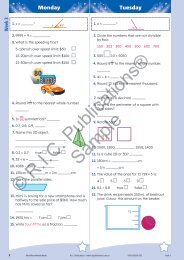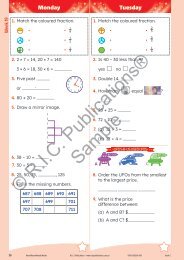RIC-3531 Primary Science - Book D (Digital)
You also want an ePaper? Increase the reach of your titles
YUMPU automatically turns print PDFs into web optimized ePapers that Google loves.
Changes to the Local Environment<br />
Changes in the Local Environment – Activity 4<br />
Lesson Focus<br />
Outcomes<br />
Earth and Beyond<br />
2.2 Describes changes<br />
that occur in the local<br />
environment.<br />
Indicators<br />
• Reads and analyses<br />
information about land<br />
clearing and the effects it<br />
has on farming.<br />
• Evaluates an area of soil<br />
that is degrading. Devises<br />
a plan to improve the<br />
condition of the soil.<br />
Skills Focus<br />
• Compares<br />
• Analyses<br />
• Conducts investigation<br />
Background Information<br />
Clearing the land has caused<br />
a number of problems. When<br />
trees and plants are cleared<br />
for farming, the soil begins<br />
to erode from wind and rain.<br />
Plants help to keep the soil<br />
in good condition with their<br />
roots, allowing oxygen to<br />
move through the soil. The<br />
roots of the trees and plants<br />
help to keep the soil together<br />
and prevent it from being<br />
blown away.<br />
Because of land-clearing and<br />
destructive farming methods,<br />
the Earth now has large areas<br />
of soil that are useless to the<br />
environment.<br />
Some farmers cause problems<br />
for soil conservation by<br />
overgrazing their land. This<br />
occurs when too many animals<br />
graze on too small an area<br />
of land. All of the grass and<br />
shrubs are eaten, leaving the<br />
soil loose and easily blown<br />
away by water and wind or<br />
carried away by water.<br />
Before the Lesson<br />
Materials Needed<br />
Pictures of farming equipment used at the turn of the century and the machines<br />
used today. An area of the school grounds where the soil is in poor condition.<br />
Preparation<br />
• Walk around the school and find areas in the school grounds where the soil<br />
appears to be in poor condition. These areas may be where students walk or play,<br />
or near a tap or water fountain.<br />
The Lesson<br />
Stimulus<br />
• Show the students a loaf of bread. Ask them where it comes from. Talk to them<br />
about wheat and the process of farming it. This includes ploughing, seeding,<br />
fertilizing and finally harvesting. Explain that to grow crops such as wheat, the<br />
condition of the soil must be good. Ask the class what might make the soil poor.<br />
Make a list.<br />
What to Do<br />
• Read the passage about farming. Show the students the pictures and photographs<br />
of the farming machinery. Compare them. Ask the students what the main<br />
differences would be when using them. Talk about time and how important it is<br />
during harvest for the crops to be collected before the wet season. (This is due to<br />
the wheat swelling and barley becoming stained.)<br />
• Students compete Question 1 (a) of the blackline; 1 (b) may need pair, group or<br />
class discussions to be completed. Discuss overgrazing with the students as another<br />
cause of soil degradation.<br />
• Explain to the students that they are going to be studying an area in the school<br />
grounds where the soil is in poor condition.<br />
• Walk around the grounds and find an area or areas that the students can study in<br />
small groups. Students complete Question 2 of the blackline.<br />
• Posters are designed and displayed to make the school aware of the degraded soil.<br />
Each week, the soil can be checked by students, who report back to the class on its<br />
condition. Through the effort of the class, the areas should start improving.<br />
After the Lesson<br />
Answers<br />
1. (a) Teacher check<br />
(b) Plant trees and native vegetation to improve the quality of the soil. Make sure<br />
they don’t overgraze the land by moving the sheep or cows from paddock to<br />
paddock and limiting stock numbers.<br />
2. Answers will vary.<br />
Additional Activities<br />
• Study other areas in the school grounds with soil degradation. Have different<br />
groups looking after the areas. Make weekly reports on any changes. Compare<br />
each site and discuss the cause and possible solution to the damage.<br />
• Research the farming methods at the turn of the century. Present the information<br />
as a poster with facts, diagrams and a time line.<br />
Display Ideas<br />
• Display the pictures and photographs of past and present farming machinery with<br />
explanations of the difference and the progression.<br />
©R.I.C. Publications<br />
Low Resolution Images<br />
Display Copy<br />
38 PRIMARY SCIENCE ~ R.I.C. Publications ® ~ www.ricpublications.com.au<br />
ISBN 978-1-925660-54-8


















